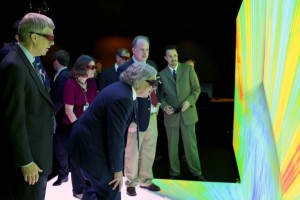‘VERA’ Software Enables Simulation of Atomic-Level Physics

Like an engaging host, VERA invites researchers to take a walk through the core of a nuclear reactor—in full-scale virtual 3-D—to observe in luminous color the neutron population density in the fuel rods (see photo at right). At Oak Ridge National Laboratory, scientists are using the western world’s most powerful supercomputer, named Titan, to operate VERA, short for Virtual Environment for Reactor Applications.
The VERA software is made up of many interacting computer codes that will enable researchers to simulate the atomic-level physics of any reactor core element at any time, with unprecedented clarity.
“Steven Chu, as Secretary of Energy, recognized that computers could be harnessed to model at the atomic level what happens in the core of a nuclear reactor,” said Neil Wilmshurst, vice president of EPRI’s Nuclear sector.
Secretary Chu set up four Energy Innovation Hubs, beginning in 2010 with the Consortium for Advanced Simulation of Light Water Reactors (CASL). Using an organizational model pioneered by the Manhattan Project and Bell Labs, Chu established CASL’s research focus and provided funds, as well as a mechanism to assemble a virtual team of scientists and engineers from national laboratories, industry, academia, and EPRI. CASL’s primary goal: Advance the nuclear industry’s modeling and simulation capabilities and use them to address design, operational, and safety challenges for light water nuclear reactors. VERA is instrumental in their work.
Oak Ridge National Laboratory was assigned to lead. Founding partners included Sandia National Laboratory, Los Alamos National Laboratory, Idaho National Laboratory, Massachusetts Institute of Technology, University of Michigan, North Carolina State University, Tennessee Valley Authority (TVA), Westinghouse Electric Company, and EPRI. “Besides our technical talent, one of the distinguishing features EPRI brings to the partnership is a strong, collaborative interface with the utility industry,” said Heather Feldman, a program manager in EPRI’s Nuclear sector.
One challenge with such an integration of science and engineering is to address both basic science and practical application. To ensure that CASL provides real-world benefits, an advisory council helps guide its work. Members include nuclear plant operators, fuel vendors, design engineering firms, and computer technology companies. “CASL made it clear from the outset that research had to be ‘used and useful,’” said Feldman.
Reactor Behavior, Coolant Flow, and Fuel Pellets
Some founding industry-related partners have established Test Stands, or platforms, for testing VERA’s modeling and simulation capabilities. Each partner focuses on a specific technical challenge. Westinghouse is examining the core’s reactivity and power distribution behavior of its advanced reactor, the AP1000®, and TVA is looking at coolant flow in the reactor vessel of its Watts Bar Unit 1 plant. EPRI’s focus is a problem involving nuclear fuel rods called pellet-clad interaction.
Cylindrical fuel pellets, less than a quarter of an inch in diameter and roughly a half of an inch long, are stacked one on top of the other in the hollow fuel rods. “Under some circumstances, if operators power up the reactor too quickly, the pellet can expand and crack the cladding, releasing radioactive material from the fuel rod,” said Feldman. “Or, if pellets aren’t perfectly round due to manufacturing, the stress on the cladding will be concentrated in certain regions, which can also lead to distortion and cracking.” EPRI is using VERA on its high-performance computer called Phoebe for modeling and simulating pellet-clad interaction. Effective solutions can lower costs, provide more operating flexibility, and lead to more complete fuel burnup.
“The computational methods and computer codes representing all the key physics to be included in VERA—neutronics, fuel performance, chemistry, and fluid flow/heat transfer—have undergone their initial development and have been integrated into the software,” said CASL director Jess C. Gehin in Congressional testimony in 2015, adding that “early deployment of VERA has been performed through CASL Test Stands.”
The U.S. Department of Energy (DOE) originally funded CASL from 2010 to 2015. In Phase 2, funded by DOE as a five-year extension, CASL will expand VERA applications to boiling water reactors and new reactor designs, including small modular reactors.
“VERA is a game-changing technology. In this development phase we’re seeing its early benefits. For example, Westinghouse used its Test Stand to reinforce its confidence in predictions for how the fuel core of the AP1000 nuclear plant will behave during startup,” said Feldman. “It will take 10 or so years to see the full effect of VERA on nuclear R&D. I expect that we will look back and say, ‘Wow, that technology really changed how we predict what is happening in a reactor.’”
EPRI Technical Expert:
Heather Feldman


